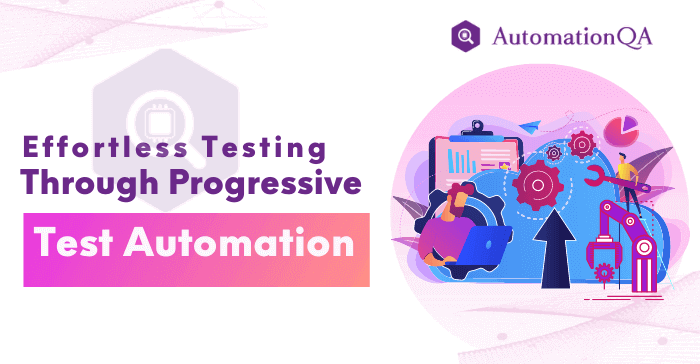
Have you ever thought about an automation process that can generate results without much hard work? Off course, it is the era of doing smart work rather than hard work. Organizations these days are opting towards progressive automation procedures as compared to classical ones.
In the process of progressive testing, the modules are tested one after another to get the right results quickly. Automated test scripts are produced alongside development code in progressive Automation for quicker testing, problem discovery, and rapid repairs. Implementing Progressive Automation requires a well-defined test strategy, a thorough understanding of the application under test, and the selection of appropriate test tools. It also requires a collaborative and iterative approach to testing, with regular feedback loops and continuous improvement. Let’s dig in more to understand the concept of progressive test automation.
Progressive test automation is like compound interest – the earlier you start, the faster your testing process will grow. – Lisa Crispin
Quick Introduction to Progressive Automation
In the process of advanced testing, the modules are tested one after another to get the right results quickly. Automated test scripts are produced alongside development code in progressive Automation for quicker testing, problem discovery, and rapid repairs.
Only two or three days are needed to complete a progression automation testing suite. However, Automation allows for the simultaneous execution of hundreds of test cases. Additionally, it helps identify the detrimental effects of programming or upgrades considerably sooner in the software development cycle.
How is Progressive Automation different from Classical Automation?
Classical testing, in which new code is tested after a project to find mistakes, is improved by advanced testing in software testing. In classical automation testing, validation is done to ensure that the existing functionality does not interrupt the flow with any changes. In contrast, progressive automation testing uses test cases to validate new functionality.
High amounts of ROI are possible within a project using progressive automation methods. On the other hand, classical automation suites are created towards the conclusion of a project with the hopes that they will be utilized again in future projects. Additionally, testing time is reduced, and testing coverage is raised.
Only two or three days are needed to complete a progressive automation testing suite. However, Automation allows for the simultaneous execution of hundreds of test cases. Additionally, it helps identify the detrimental effects of programming or upgrades considerably sooner in the software development cycle. By the end of this guide, you will have a better understanding of how to optimize your testing efforts and deliver high-quality software at a faster pace.
Steps in Implementing Progressive Test Automation
In contrast to regression automation, automation for progression requires the testing team to be involved from the first day of development. Understanding the application design while the development code is being created simultaneously is vitally essential.
Functional test cases primarily focus on business objectives, and testing is carried out in line with the specifications and use cases supplied by the design team. Functional testing validates an application’s behavior. In this situation, the tester must approve the application to confirm whether or not all specified criteria have been implemented. Functional testing always takes client requirements into account.

HLD offers a comprehensive System Design and aids developers in comprehending the whole system’s architecture, from the primary module to each sub-module. The application created in HLD is segmented into modules and programs in LLD.
Before an application is released, end-to-end test cases are a must. The program is tested in actual scenarios, including interactions with hardware, databases, networks, and other applications. The exchange of reliable information between the various system components is also guaranteed by this method.
Tools and Technologies Used in Progressive Test Automation
Choosing a tool might be difficult for you, and thus here is a list of prominent features and websites for Automation Testing tools.
ACCELQ: ACCELQ is a cloud-based AI-powered Codeless Test Automation system that effortlessly automates testing for web user interfaces, APIs, mobile devices, and desktop computers. ACCELQ is used by Fortune 500 firms globally from various industry verticals to advance their automation ambitions dramatically.
AVO Assure: 100% no-code test automation is possible using Avo Assure automation tools. It supports over 200 technologies and allows you to test intricate, end-to-end business procedures utilizing the web, mobile devices, desktop computers, mainframes, SAP, Oracle, Salesforce, and other platforms.
Selenium: Selenium is a popular and frequently used open-source web automation technology currently in demand. It is one of the most excellent QA automation tools available.
Strategies for Establishing a Sustainable Testing Process with Progressive Test Automation
How do you integrate progressive automation testing into your company’s software testing procedures?
- Start by creating a reasonable, compact test suite that is simple to automate. Try to avoid automating everything at once; you will just become overburdened.
- Second, gradually broaden the range of what you’re testing after automating your test suite. To do this, you may either create new tests, increase the coverage of current tests, or do both at once.
- Third, be confident that you have a mechanism to monitor the development of your automation initiatives. This will enable you to identify what is and isn’t functioning so that you can make the required modifications as you go.
Benefits of Progressive Automation
The advantages of Progressive Test Automation, which begins concurrently with the development process, are numerous and are detailed below.
Coverage of risks: End-to-end test cases are conducted to ensure proper communication between different system components because progressive Automation is all about verifying new functionality. It guarantees appropriate risk protection.
Time-saving: The scripts can be run several times to find flaws (during the early stages of the software development cycle) saving the time and money needed to resolve or retest the reported faults.
Better returns: Progressive testing is considered to increase the value of the project. It saves time and generates better-quality results. Project risk is significantly decreased as a result.
Challenges Faced with Progressive Automation
The idea of Progressive Test Automation is a pipe dream to you. It certainly is in many ways! But it also has specific difficulties attached to it.
- Automation scripts: Progressive Automation involves automating practically all test cases rather than running them manually. Testers and business users need to be more programmers. Thus script-based test automation techniques won’t work.
- Maintenance of test script: Updating the test script may be necessary due to data collection, functionality, or schema structure changes.
- End-to-end testing: Before the release of an application, end-to-end test cases are a must. Finding a test automation platform that covers the complete technological stack is challenging.
Conclusion
Introducing Automation into the testing process progressively is the goal of the testing method known as Progressive Test Automation This strategy may be helpful for businesses that want to use Automation more but are still deciding whether to commit entirely. It’s critical to grasp your objectives and goals. In addition to being willing to devote time and money to training and development, you must select the tools and technologies that are most suited to your requirements.
